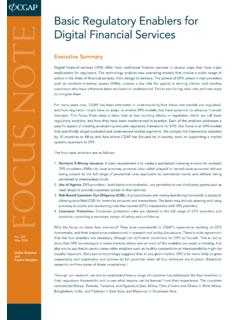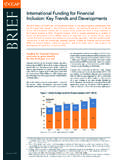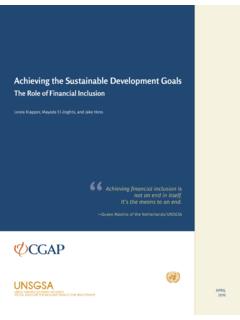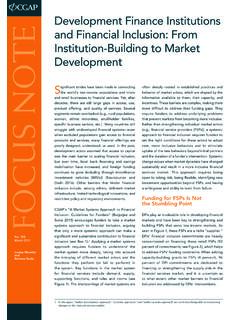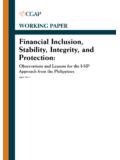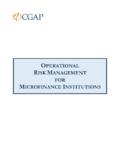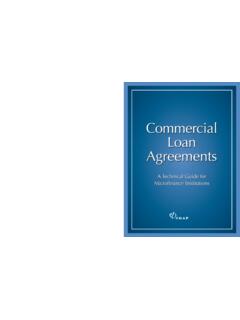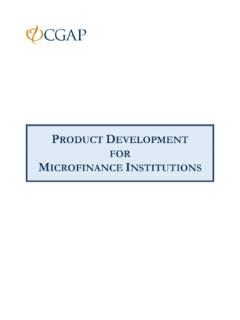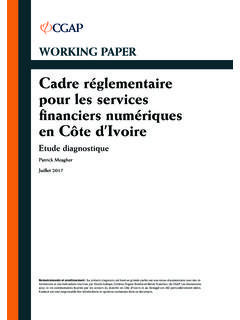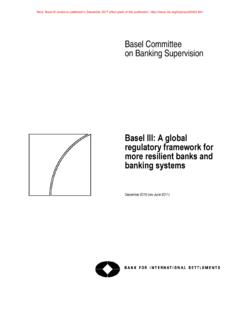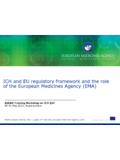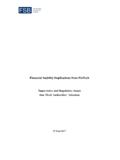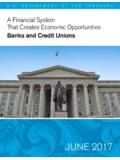Transcription of Ivo Jenik and Kate Lauer October 2017 - CGAP
1 WORKING PAPERR egulatory Sandboxes and financial InclusionIvo Jenik and Kate LauerOctober 2017iiRegulatory Sandboxes and financial InclusionACKNOWLEDGMENTSThis paper was prepared by Ivo Jenik , financial sector specialist (CGAP), and Kate Lauer , senior policy consultant (CGAP), with contributions from Lisa Kristina Stahl, financial sector analyst (CGAP), under the leadership of Gregory Chen, lead financial sector specialist (CGAP) and Timothy Lyman, lead financial sector specialist (CGAP). Peer review comments were provided by Schan Duff, a senior fellow in the Aspen Institute s financial Security Program, Philip Rowan, international lead at financial Conduct Authority s Innovation Hub, and Marianna Nunan, senior publishing officer (CGAP).
2 The authors would like to thank the Bank of England, the financial Service Authority of Indonesia, the Bank of Indonesia, the Hong Kong Monetary Authority, the Hong Kong Securities and Futures Commission, the Capital Markets Authority of Kenya, Bank Negara Malaysia, Bangko Sentral ng Pilipinas, the Securities Commission Malaysia, the Monetary Authority of Singapore, the financial Conduct Authority of the United Kingdom, the financial Sector Deepening Trust Africa, the United Nations Capital Development Fund, and many other stakeholders including numerous FinTech firms for invaluable H Street NW, MSN IS7-700 Washington DC 20433 Internet: Email: Telephone: 11 202 473 9594 Rights and PermissionsThis work is available under the Creative Commons Attribution IGO license (CC BY IGO) By using the content of this publication, you agree to be bound by the terms of this license.
3 For attribution, translations, adaptations, and permissions, see the provisions and terms of use at # citation: Jenik , Ivo, and Kate Lauer . 2017 . regulatory Sandboxes and financial Inclusion. Working Paper. Washington, : queries on rights and licenses should be addressed to CGAP Publications, 1818 H Street, NW, MSN IS7-700, Washington, DC 20433 USA; e-mail: cgap@world Sandboxes and financial InclusionI. INTRODUCTIONA regulatory sandbox is a framework set up by a financial sector regulator1 to allow small scale, live testing of inno-vations by private firms in a controlled environment (operating under a special exemption, allowance, or other limited, time-bound exception) under the regu-lator s supervision.
4 The concept, which was developed in a time of rapid techno-logical innovation in financial markets, is an attempt to address the frictions between regulators desire to encourage and enable innovation and the empha-sis on regulation following the financial crisis of 2007 regulatory sandbox introduces the potential to change the nature of the relationship between regulators and fi-nancial services providers (regulated or aspiring) toward a more open and active dialogue. It may also enable the regula-tor to revise and shape the regulatory and supervisory framework with agility. However, establishing a sandbox should not distract policy makers who are fac-ing elementary regulatory challenges nor should it be expected to affect the mindset change in that many view as necessary for regulators to keep up with the FinTech establish sandboxes for var-ious reasons, but the most common reason is to promote competition and efficiencies in financial services markets through innovation.
5 Whether a sandbox succeeds in its objectives will depend on how it is framed and, fundamentally, on market conditions (providers, com-petition, quality of innovations, level of development of the financial mar-ket infrastructure, customer trust and engagement).Concepts like regulatory sandboxes have been applied in nonfinancial sectors ( , coding sandboxes for software de-velopment and clinical trials) (Innovate Finance 2016b; GOS 2015). financial sec-tor regulators have often been involved in a reactive catch-up game and have occasionally opted for an ad hoc solution, such as in case of M-Pesa in first sandbox-like framework was set up by the Consumer financial Protection Bureau (CFPB) in 2012 under the name Project Catalyst (CFPB 2016).
6 In 2015, the financial Conduct Au-thority (FCA) coined the term regulato-ry sandbox (FCA 2015). Since then, the concept has spread across more than 20 countries from Abu Dhabi to Sierra addition to regulatory sandboxes, or in the absence of one, several coun-tries have adopted other mechanisms that support financial innovation ( in-novation facilitators ).2 These include (FinTech) innovation hubs, (FinTech) incubators, (FinTech) accelerators, and industry sandboxes. Innovation facilitators are part of a broader eco-system for innovation and may comple-ment a sandbox because they have the landscaping potential to inform broader FinTech policy development (and the selection of companies to participate in the sandbox).
7 The importance of innovation for fi-nancial inclusion is well-established. Whether regulatory sandboxes may play a role in harnessing innovation to sup-port financial inclusion remains to be seen. While low levels of financial in-clusion remain prevalent in emerging 1 Unless noted otherwise, regulators is used in the paper as a generic term that refers to regulators and See, , FSB (2016).2 regulatory Sandboxes and financial Inclusionmarkets and developing economies (EMDEs), innovations are present and hold the promise of positive change. financial sector regulators need to be responsive to this opportunity, but they face challenges due to several factors: Lack of regulatory capacity in terms of adequate resources, staff, exper-tise, and Underdeveloped financial market in-frastructure and limited market with retail financial services.
8 Complexities of balancing key regu-latory objectives of financial inclu-sion, stability, integrity, consumer protection, and working hypothesis is that regula-tory sandboxes can enable innovations that are likely to benefit excluded and un-derserved customers. Practical examples of such innovations range from mobile money to remote customer identification enabled by a biometric technology. In some instances, for those innovations to be realized, a sandbox would be helpful; in other instances, a sandbox may play a marginal role, if any. Indeed, a regulatory sandbox is not a one-size-fits-all solution, and there may be other approaches that are more efficient, nimble, and respon-sive to the paper is based on a combination of desk research and interviews with selected regulators, sandbox firms, supervisors, and other stakeholders.
9 It is for financial sector regulators in EM-DEs, development agencies, and finan-cial inclusion professionals who want to better understand regulatory sandboxes and their (potential) impact on digital financial inclusion. The paper is orga-nized as follows: Section II provides an overview of the current landscape for regulatory sandboxes. It then analyzes potential benefits and risks of the sandbox concept in the context of financial inclusion. Section III outlines key issues that every policy maker who is consider-ing establishing of a regulatory sand-box should be aware of. Section IV offers concluding remarks and speculative points about future developments.
10 Annex 1 includes a list of countries that use a regulatory sandbox and a simplified comparative analysis of regulatory sandboxes organized around specific design components. Annex 2 includes a snapshot of sand-box firms. Annex 3 provides illustrative exam-ples of alternative approaches to the regulatory See, , GPFI (2016).3 regulatory Sandboxes and financial InclusionII. regulatory SANDBOX AND financial OverviewRegulatory sandboxes prevail in high- and middle-income countries a ma-jority of which do not struggle with significant financial inclusion problems (see Annex 1). This may explain why most regulatory sandboxes were not designed to primarily promote financial inclusion.
